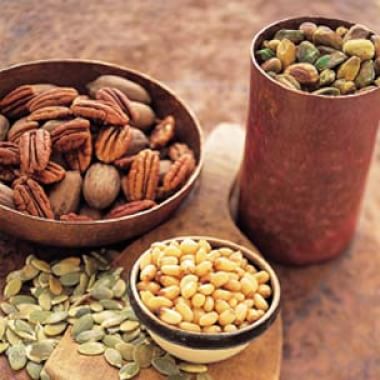
Nuts find favor in kitchens the world over. Almonds thicken romesco sauce in Spain, cashews add crunch to curries in India, pecan halves generously fill pies in the American South, and rose-scented pistachios nestle among phyllo layers in Greece.
An essential ingredient in virtually every cuisine, nuts provide richness, flavor, body, crunch and vital nutrients in dishes both sweet and savory. In their purest form, with their varied shapes and hues, unshelled nuts piled high in a festive bowl help mark the autumn season.
Most nuts have a hard shell, a protective coating developed by plants to shield their seeds from hungry animals. Inside each shell is usually one edible kernel. Once a staple in the diets of early hunter-gatherers, nuts are dense in nutrients, especially potassium, iron, vitamin E and the B vitamins. But since they boast a high amount of fat and calories as well as proteins, nuts are best used in moderate amounts. Fortunately, even a light sprinkle of nuts will add noticeable flavor and texture to a variety of dishes, such as pasta, salad or ice cream.
Selecting
Nuts in the shell remain fresh longer and are preferable if you have the time and inclination to shell them yourself. Look for whole nuts that are free of holes, cracks and mold. Shake their shells; a rattling sound inside indicates old and dried nutmeats. Look for whole nuts sold in bulk at health-food stores or in specialty markets. Buying nuts in bulk is economical, but be sure that the store has a rapid turnover so you can purchase the nuts as fresh as possible. Nuts in the shell are best from autumn to early winter.
Shelled nuts should be plump and crisp. Avoid kernels that look withered or lack a snap when broken. Shelled nuts come whole, halved, chopped and sometimes ground. Almonds can also be blanched (skinned), slivered or sliced, and chestnuts are available dried, vacuum-packed, candied or pureed. Supermarkets stock shelled nuts in plastic bags or vacuum-sealed jars and cans year-round.
Many nuts are available raw, roasted or dry-roasted. Commercial roasted nuts tend to have more flavor, since they are actually fried in oil. On the other hand, no additional oil is used in the preparation of dry-roasted nuts. Nuts for snacking may be salted, smoked or sweetened. Popular flavorings include garlic, jalapeño and honey.
Occasionally, fresh green almonds or walnuts appear at farmers' markets during the late summer. Their tender, buttery flesh is a treat for snacking or grinding into a flavorful spread.
Storing
Since they contain high amounts of oil, nuts will eventually turn rancid. Raw, unshelled nuts keep well for 6 months to 1 year if stored away from light, heat and moisture. On the other hand, shelled nuts, especially chopped and unsalted ones, are convenient but have a shorter shelf life. Store shelled nuts in an airtight container for 1 to 2 months at room temperature, 3 to 6 months in the refrigerator, or 9 months to 1 year in the freezer in a zippered plastic freezer bag. (Exceptions: Pistachios with partially opened shells will keep for only about half as long as other nuts; fresh chestnuts should be kept for no more than 1 week at room temperature, 1 month in the refrigerator or 6 months in the freezer.) Be sure to check nuts for freshness before adding to recipes; rancid nuts will ruin the flavor of other foods.
Although nut butters can remain at room temperature for several weeks, it is best to store them in the refrigerator, where they will keep for up to 6 months. Since they are highly perishable, keep nut oils in the refrigerator for up to 4 months once they have been opened. Store nut flours in an airtight container or zippered plastic freezer bag in the freezer for 6 to 9 months.
Adapted from Williams-Sonoma Kitchen Companion: The A to Z Guide to Everyday Cooking, Equipment and Ingredients (Time-Life Books, 2000)








